Biomolecules - Revision Notes
CBSE Quick Revision Notes
CBSE Class-11 Biology
CHAPTER-09
BIOMOLECULES
- Chemicals or molecules present in the living organism are known as biomolecules. Biomolecules are divided into two types- inorganic and organic.
- Inorganic biomolecules includes minerals, gases and water and organic biomolecules includes carbohydrates, fats, proteins, nucleic acids, vitamins, etc.
- Different biomolecules can be classified as aldehyde, ketones and aromatic compounds as chemical forms. The amino acids, nucleotides and fatty acids can be classified as biochemical forms.
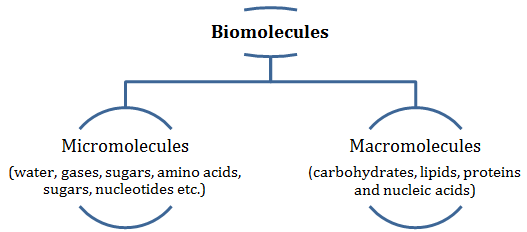
- Except lipids, macromolecules are formed by polymerization of sub-units called monomers.
- Proteins are polymers of amino acids. Amino acids are linked by peptide bond formed by dehydration between COOH group of one amino acids and NH3 group of next with the removal of H2O.

- In nucleic acids, the phosphate molecules links 3’ C of sugar of one nucleoside to the 5’ C of sugar of next nucleosides releasing two water molecules to form 3’-5’ phosphodiester bond.
- In polysaccharides, the mono-saccharides are linked by glycosidic bonds formed by dehydration between two carbon atoms of two adjacent monosaccharides.

Carbohydrates (Polysaccharides)
- Polysaccharides are long chain of sugar containing different monosaccharaides as a building block.
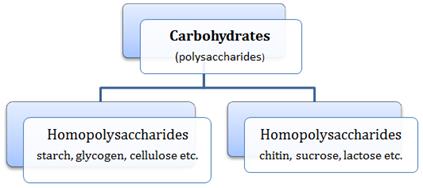
- Starch is present in plants as store house of energy. It forms helical secondary structure. It can hold the I2 molecules in the helical structure.
- Cellulose molecules contain glucose molecules joined together by 1-4 β linkage. It is the most abundant organic molecules on earth.
- Glycogen is called animal starch as it is the reserve food materials for animals, bacteria and fungi. In this, glucose molecules are arranged in highly branched bush like chain having two types of linkage 1-4 α in straight chain and 1-6 linkage in branching.
Proteins are polypeptide chains made up of amino acids. There are 20 types of amino acids joined together by peptide bond between amino and carboxylic group. There are two kinds of amino acids-
- Essential amino acids are obtained by living organism along with food.
- Non-essential amino acids can be prepared by our body from raw materials.
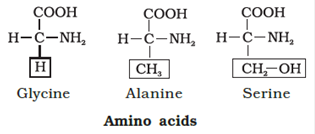
- The main functions of protein in living cell are
- Transport of nutrient across the membrane.
- Fight infectious organisms.
- Produce enzyme and proteins.
- Collagen is the most abundant protein in animal world.

- Primary structure of protein is the basic structure of protein in which a number of polypeptides are involved having sequence of amino acids. The first amino acid of sequence is called N-terminal amino acid and last amino acid of peptide chain is called C-terminal amino acid.

- Secondary structure protein threads forms helix. There are three types of secondary structure- α helix, β pleated and collagen. In α helix, the polypeptide chain is coiled spirally in right handed manner.
- In β pleated secondary proteins two or more polypeptide chains are interconnected by hydrogen bonds. In collagen there are three strands or polypeptides coiled around one another by hydrogen bonds.
- In Tertiary structure long protein chain is folded upon itself like a hollow woollen ball to give three dimensional view of protein.
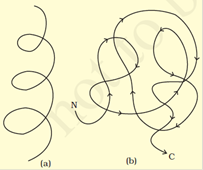
(a) secondary structure (b) Tertiary structure
- In Quaternary structure each polypeptide develops its own tertiary structure and function as subunit of protein. Eg. Hemoglobin. In adult human hemoglobin 4 sub-units are involved. The two subunits are of α type and two subunits of β types.
Nucleic Acid: Nucleic acids are polynucleotides. A nucleic acid has three chemically distinct components- heterocyclic compound ( nitrogenous base), polysaccharides ( ribose/ deoxy-ribose sugar) and phosphate or phosphoric acid.

- The sugar found in nucleic acid is either ribose or deoxyribose. Nucleic acid containing deoxyribose sugar is called DNA (Deoxyribonucleic Acid) and those containing ribose sugars are called RNA (Ribonucleic acid).
- Biomolecules are constantly being changed into some other biomolecules and also made from other biomolecules. This breaking and making is through chemical process called metabolism.
- In living organism, all the metabolic reactions are enzyme catalyzed. Catalysts are those substances that alter the rate of reaction. The protein with catalytic power is called enzyme.
Metabolic Basis for living organism
- The metabolic pathways that lead to more complex structure from simpler structure are called biosynthetic or anabolic pathways and those pathways that lead to simpler structure from complex structure are called catabolic pathways.
- Photosynthesis and protein synthesis are example of anabolic pathway. Respiration and digestion are examples of catabolic pathway.
- ATP (adenosine triphosphate) is the most important form of energy currency in living world.
- All living organism exist in steady state characterized by concentration of each of the metabolites. The living state is a non-equilibrium steady state to be able to perform work.
Enzymes
- Enzymes are commonly proteinaceous substances which are capable of catalysing chemical reactions of biological origin without themselves undergoing any change. They are commonly called as biocatalysts.
- The nucleic acids that behave like enzymes are called ribozymes.
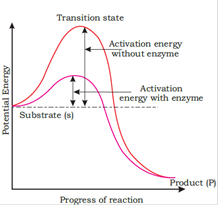
- The tertiary structure of protein/Enzyme has pockets or crevice into which substrate fit to form ES complex.
- The formation of the ES complex is essential for catalysis.
E + S ES →EP →E + P - The structure of substrate gets transformed into the structure of product through formation of transient state structure.
- The major difference between inorganic and organic catalyst is inorganic catalyst works effectively at high temperature and pressure but enzyme get damaged at high temperature.
- The external energy required to start a chemical reaction is called activation energy.
Factors influencing Enzyme Activity
- Temperature- An enzyme is active within a narrow range of temperature. Temperature ate which enzyme is most active is called optimum temperature. The enzyme activity decrease above and below this temperature.

2. pH – every enzymes has an optimum pH at which it is maximum active. Most of the
intracellular enzymes work at neutral pH.
3. Concentration of Substrate- increase in substrate concentration increases the rate of
reaction due to occupation of more active sites by substrate.
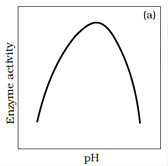
Competitive Inhibitor- when the molecular structure of inhibitor resembles the substrate, it inhibits the function of enzymes.
Enzymes are classified as
1. Oxidoreductases/Dehydrogenases-
S reduced + S' oxidised S oxidised + S' reduced
2. Transferases
S - G + S' S + S' - G
3. Hydrolases catalyses the hydrolysis of peptide, ester, glycosidic bonds et
4. Lyases remove the groups from substrate.

5. Isomerases-inter conversion of optical, geometrical or positional isomers.
6. Ligases – catalyses the linking together of two compounds.
Co-factors are the non-protein constituent of an enzyme which make the enzyme more catalytically active. The protein portions of enzyme are called apoenzyme.

Prosthetic groups are organic compounds and are tightly bound to the apoenzyme. For
example, in peroxidase and catalase, which catalyze the breakdown of hydrogen peroxide, haem is the prosthetic group
The essential chemical components of any coenzymes are vitamins. Example, coenzyme NAD and NADP contain the vitamin niacin